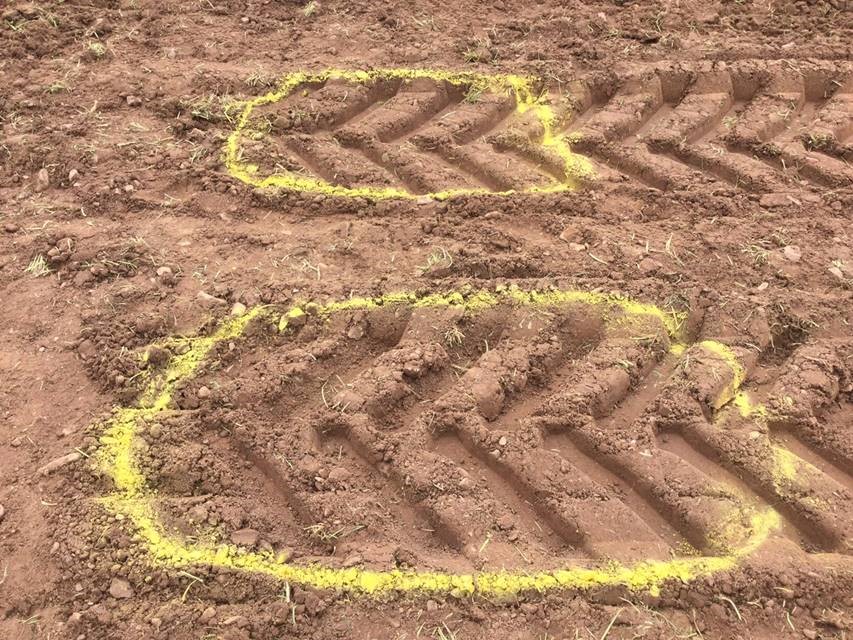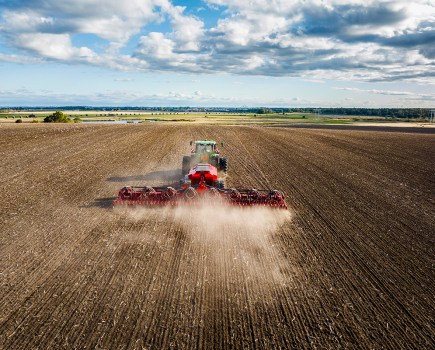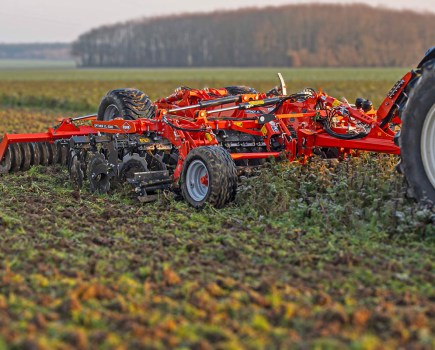Getting the best from recent advances in tyre technology may mean a better understanding of their use and the inflation pressures needed for specific operations. CPM finds out how this is done.
It’s not enough to simply purchase the most advanced tyres you can.
By Rob Jones
Tyre technology has moved on. So much so, claims Trelleborg UK technical and field support manager Neil Sharman, that many producers are now turning their backs on tracked machines. Instead, high horsepower tractors are shod with advanced tyres, offering the latest technologies to bring maximum performance to the field.
So how do you ensure you deliver the full potential on offer and avoid costly mistakes? “It’s not enough to simply purchase the most advanced tyres you can. There’s also the concept behind them and understanding how they should be operated,” notes Neil.

The difference in footprint size can be considerable when you compare incorrect (top) and correct (bottom) pressures on the same vehicle, same tyre and with the same load.
“Tractor power and operating speeds are so much greater these days that if you operate large, high-value tractors, knowledge of how the new tyres are constructed, and how they differ from standard fitments is important.”
In Neil’s experience, problems can typically occur when operators move up to a significantly larger tractor, for example from a 180hp model to one of 250hp, without adjusting ballast and pressures accordingly.
“Adjusting tyre pressures is often difficult because most tractors aren’t fitted with a compressor, so operators will choose an average pressure based on what they’ve used before or which they believe to be a happy compromise between the ideal settings for field work and on-road driving.
“I’ve seen tyres destroyed in less than 300 hours, sometimes much less, because the operator simply didn’t know how to use them correctly or take the time to find out.
“The way that the latest tyres are constructed means that when looking at the sidewalls, they can appear to be underinflated even when at the correct pressure.
“But they’re designed that way to maximise the ground contact area, deliver optimum traction and performance with reduced soil compaction. That said, correct set-up is vital.”
The latest IF (Increased Flexion) tyres improve tyre performance by 20% compared with standard radial tyres, while VF (Very High Flexion) tyres increase that to 40%, he explains.
“This means that an IF tyre will carry 20% more load at the same pressure as a standard tyre, or the same load at 20% lower pressure, while the VF tyre will carry 40% more load at the same pressure, or the same load at 40% lower pressure.
“These characteristics are very important for road transport and heavy draft work as well as secondary cultivations and operations such as drilling.
“This is particularly the case given the increasing trend towards more direct seeding where it’s vital to minimise damage to the soil and avoid the need for remedial cultivations.”
Recognising correct operation is essential, Trelleborg has offered its customers a free on-farm set-up service for over 20 years.
The set-up starts with weighing the tractor with no ballast and this is then repeated with any front ballast weight that would normally be used to give the maximum load on the front axle, Neil Sharman explains.
“This is important, because most operators will use the weights that they have available, rather than calculating whether it’s correct.
“We then weigh the tractor again with any rear wheel weights fitted, then with the various mounted implements with which the tractor might be used.
“Those measurements tell us the maximum front axle load without an implement and the maximum load on the rear axle when the implement is raised.
“We then discuss how to set the tractor and tyres correctly and following the visit send the customer an email with all the data, plus a laminated sheet showing the correct tyre pressure settings that the operator can keep in the cab.”
Large-scale farming operation moves on from tracks
At South Pickenham Estates in Norfolk, ensuring the correct set up of the business’ new Fendt 939 Vario involved weighing the tractor by itself and then with drill, harrow and plough attached.
The high cost of replacing tracks damaged by flints, combined with the recent advances in tyre technology, persuaded the 3000ha estate to change its 380hp Challenger 765 tractor this spring in favour of the 396hp Fendt.
“The Challenger was used mainly for secondary cultivations and drilling, but the big issue was that flints would get caught between the tracks and idler wheels,” recalls South Pickenham farms manager James Brown.
“They became embedded in the rubber causing the tracks to wear from the inside out, cut through the steel reinforcing belts and shredded the covering on the idler wheels.
“We did well to get 2000 hours from a set of tracks and they cost around £14,000 to replace, so it was a very expensive machine to operate under our conditions,” he notes.
“The key reason for choosing the Fendt 939 was that it was the only tractor with an integrated tyre pressure regulation system, and our 237hp Fendt 724 Vario had provided good experience of the brand.
“The Fendt VarioGrip system is very important because it allows the operator to optimise tyre pressures for field operations and road travel at up to 65km/h, at the touch of a button.”
To replicate the large footprint of the Challenger 765, it was decided to upgrade the tyres on the Fendt 939.
“As standard, it’s fitted with 600/70R34 front and 710/75R42 rear tyres, but our goal was to reduce the ground pressure as much as possible while keeping with legal width restrictions for road work so we specified Trelleborg’s TM1000 High Power, 710/60R38 at the front and 900/60R42 on the rear axle.”
The Trelleborg set-up involved weighing the tractor with the implements that would be used most regularly including a 6m Väderstad Rapid drill, 6m Kuhn power harrow and 7f Dowdeswell reversible plough. From that information, Neil produced load and pressure tables, which showed the operator what pressures to use for specific tasks and how to get the best out of the tyres.
“Tyre technology has come a long way in recent years and I know many other farmers who, like us, have changed from tracks to tyres,” says James.
“Once the Challenger had finished its specific tasks for the season it just stood in the yard, whereas the Fendt 939 can be used throughout the year, is much more comfortable, causes less soil damage and will hopefully be less expensive to operate.”
Get guidance on tyre set-up
Peter Kemp of leading independent tyre distributor Bush Tyres stresses it’s essential to seek expert advice when considering changing tyres whether on existing tractors or when specifying fitments for new equipment.
“This is especially so on four-wheel-drive machines but in all cases fitting the wrong or ill-matched sizes can cause transmission ‘wind-up’, which can lead to costly failure.
“This aspect is especially important where the manufacturer offers a choice of transmission options, so it’s essential to know the exact specification and tailor the wheel and tyre package accordingly.”
According to Trelleborg’s Neil Sharman, while IF and VF tyre technologies are relatively new, they offer huge benefits.
“From a practical point of view, one of the main advantages is their ‘one pressure curve’ concept. This means that, provided you don’t exceed the load rating for your set-up, you can operate in the field or on the road at the same inflation pressure.
“That’s a significant advantage, even on tractors equipped with a tyre inflation system.”
New developments on show at LAMMA
Other significant developments designed to improve in-field performance, reduce soil compaction and make the tractor operator’s life easier are now being introduced, says Trelleborg UK marketing manager Jonathan Hewitt.
Increasing demands are put on equipment and there’s a growing need to be mindful of protecting natural resources, he notes. “While much of this is down to correct tyre choice, management and inflation pressures for different tasks, new technology can also play a leading role.”
For example, Trelleborg’s VIP (Variable Inflation Pressure) system could have a significant effect on the management of soil compaction, he believes.
“VIP automatically monitors and adjusts the tyre pressure of a combine harvester during use to ensure the right pressure is always used, at the right time and in the right place.
“By responding to the precise load at any given time, tyre footprint is kept constant with trials showing a 10.5% reduction in soil compaction and a 5% gain in crop yield when compared with a standard wheel.”
Another new development is Trelleborg ConnecTire which is a sensor-based system designed to improve traction efficiency through monitoring tyre pressure and minimising tyre slippage on the rim, Jonathan Hewitt points out.
“ConnecTire constantly monitors tyre pressure and temperature with data relayed to both the tractor and farm computers via Bluetooth and wireless connectivity.
“You simply set your target tyre pressure and should this value deviate significantly, ConnecTire alerts you via its app so you can make adjustments as necessary. It also informs you, if it detects tyre slippage.”
- Trelleborg is exhibiting at LAMMA 2019 in Hall 10 stand 10.220. Technical specialists will be on hand to talk through options for different equipment including tractors and combines as well as demonstrating ConnecTire, VIP and the new TLC Plus app for smartphones, tablets and computers.




